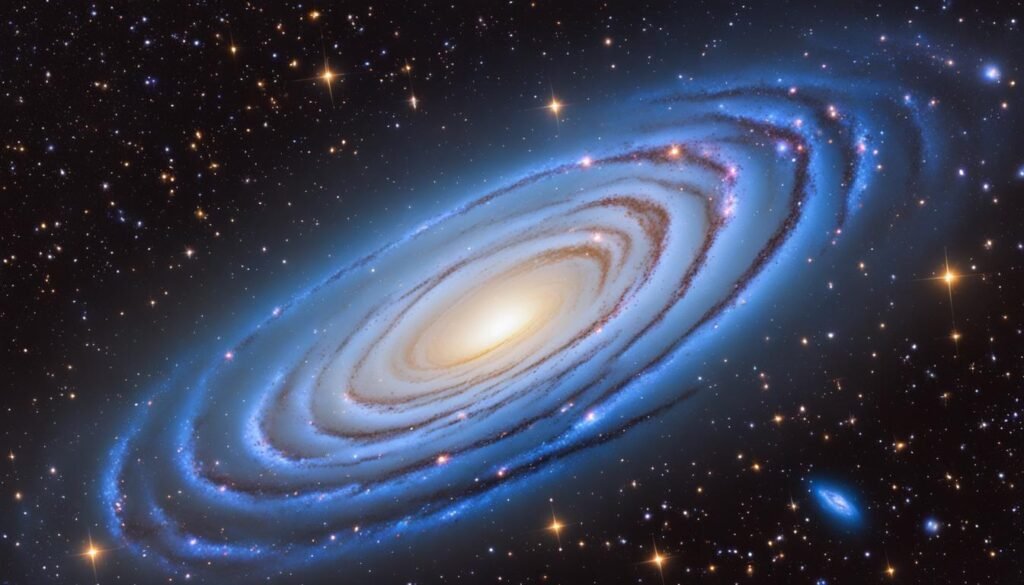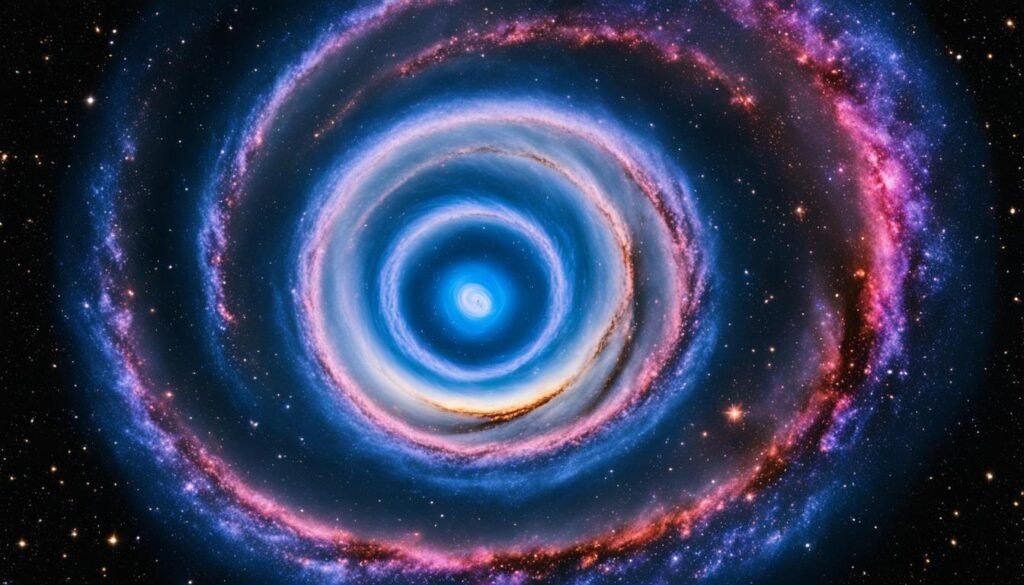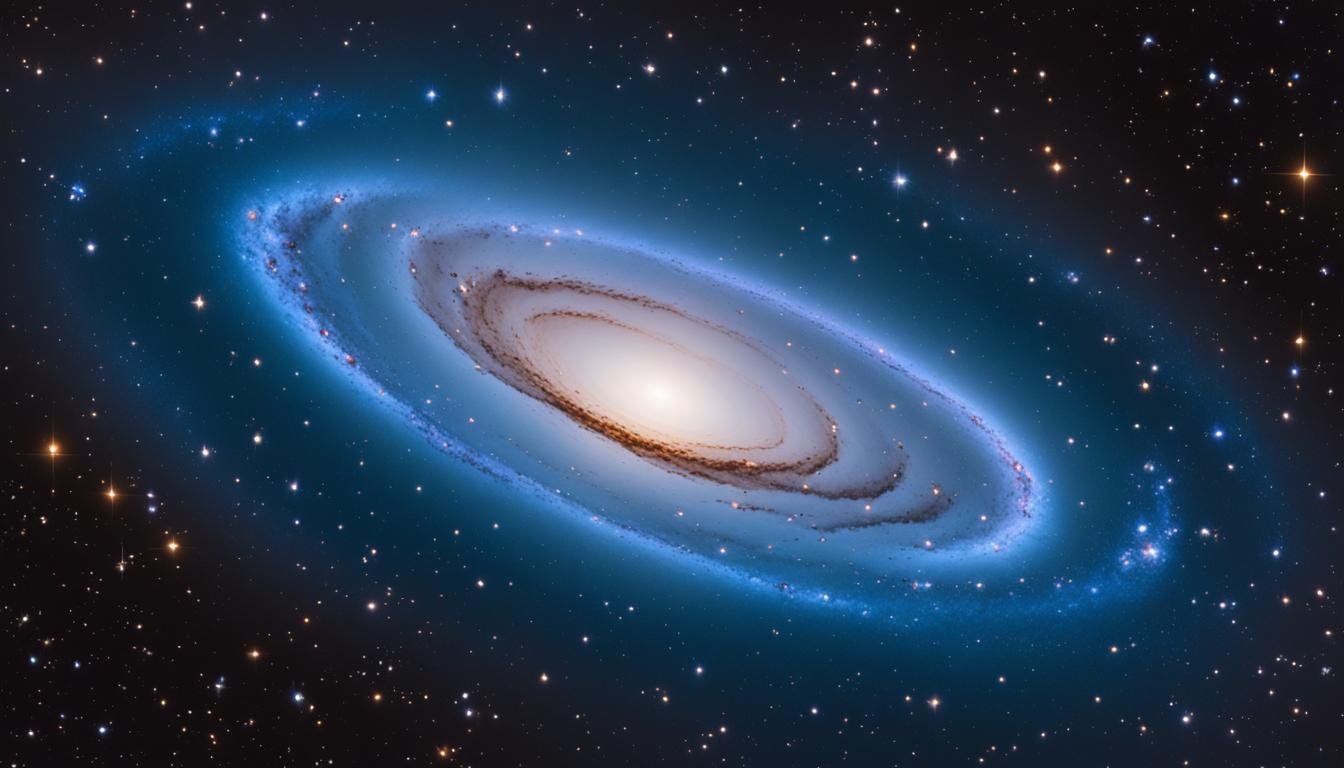Welcome to the fascinating world of Messier 86, a massive elliptical galaxy nestled within the Virgo Cluster. This astronomical object has captured the attention of scientists and stargazers alike, sparking curiosity about the mysteries of deep space and the wonders it holds. As you embark on a journey to understand this celestial body, prepare to delve into the depths of the galactic center and uncover the secrets hidden within its vast expanse.
Key Takeaways:
- Messier 86 is a massive elliptical galaxy located in the Virgo Cluster.
- It is an astronomical object that has fascinated astronomers and space enthusiasts for centuries.
- Exploring Messier 86 provides valuable insights into the nature of deep-sky objects.
- The galactic center of Messier 86 holds clues to its unique characteristics and cosmic discoveries.
- Messier 86’s inclusion in astronomical catalogs highlights its significance in the field of astronomy.
Characteristics of Messier 86
Messier 86 is a fascinating astronomical object with unique characteristics. It is classified as either an elliptical galaxy of type E3 or a lenticular galaxy of type S0(3). With an apparent magnitude of 8.9, Messier 86 appears relatively bright in the night sky. Its apparent size measures 8.9 arc minutes by 5.8 arc minutes, making it a notable feature in the Virgo constellation.
One of the striking features of Messier 86 is its rare blue shift, indicating its motion towards the Milky Way at approximately 244 km/s. This peculiar velocity sets it apart from other members of the Virgo Cluster. The galaxy has an oval shape with a brighter center, drawing attention to its distinctive structure.
Messier 86 is particularly renowned for its rich array of globular clusters. These clusters are tightly bound collections of stars that orbit around the galaxy’s center. With approximately 3,800 globular clusters, Messier 86 boasts an impressive population. These clusters play a vital role in deepening our understanding of galactic formation and evolution.
In summary, Messier 86 is an elliptical or lenticular galaxy with intriguing characteristics. Its apparent magnitude, apparent size, blue shift, and globular clusters make it a captivating subject for astronomers and space enthusiasts.
Note: The image above provides a visual representation of the notable features of Messier 86.
Location and Observability of Messier 86
Messier 86, a majestic galaxy, can be found in the vibrant Virgo constellation, situated near the border with Coma Berenices. To locate Messier 86, envision yourself standing in the middle of a cosmic bridge, halfway between the radiant star Denebola in Leo and the brilliant Vindemiatrix in Virgo. The galaxy’s positioning places it in the vicinity of other captivating celestial objects within the Virgo Cluster, including Messier 84 and Messier 87.
While Messier 86 isn’t visible to the naked eye, it unveils itself as a faint, awe-inspiring patch of light when observed through binoculars under favorable atmospheric conditions. Binoculars reveal a glimpse of its celestial beauty, capturing the intricate details of its oval shape.
For a more profound encounter with Messier 86, telescopes offer an enhanced viewing experience. Through the lens of a telescope, the galaxy’s oval form becomes more pronounced, showcasing its distinctive characteristics. Furthermore, telescopes may unveil additional faint galaxies within the field of view, enriching the cosmic spectacle.
| List of Observability | Visibility |
|---|---|
| Binoculars | Faint patch of light |
| Telescopes | Reveals the oval shape and potential fainter galaxies in the field of view |
Messier 86 and the Virgo Cluster
Messier 86 holds a prominent position as one of the brightest members at the center of the Virgo Cluster. This massive elliptical galaxy forms a visually striking pair with Messier 84, extending over an impressive distance of approximately 300,000 light-years. In addition to these two galaxies, the vicinity of Messier 86 is home to several other notable celestial objects. One such example is the interacting pair of galaxies, NGC 4435 and NGC 4438, commonly referred to as the Eyes Galaxies or Arp 120. Another neighboring galaxy is the edge-on spiral NGC 4402. A fascinating feature of Messier 86 is its inclusion in Markarian’s Chain, a captivating alignment of galaxies that showcases a intriguing curved formation when observed from Earth.
Here’s a visually engaging representation of the notable members in the vicinity of Messier 86:
| Galaxy | Common Name |
|---|---|
| Messier 84 | |
| Messier 86 | |
| NGC 4402 | |
| NGC 4435 & NGC 4438 | Eyes Galaxies or Arp 120 |

Through continued exploration of the Virgo Cluster, astronomers gain valuable insights into the intricate nature of galactic interactions and the formation of cosmic structures. With its central position and distinguished companions, Messier 86 provides an exceptional opportunity to study the gravitational forces at play in this remarkable celestial neighborhood.
Ram Pressure Stripping and Blue Shift in Messier 86
Messier 86, a member of the Virgo Cluster, is currently experiencing a fascinating phenomenon known as ram pressure stripping. This occurs when a galaxy moves at a high velocity through the cluster, causing the gas within the galaxy to be stripped away due to the intense pressure exerted by the surrounding intracluster medium.
The result of ram pressure stripping in Messier 86 is the formation of a spectacular tail trailing behind the galaxy. This tail consists of hot gas that has been forcefully expelled from the galactic disk. X-ray observations have provided valuable insights into this process, capturing the presence of this gas trail.
One notable observation in Messier 86 is the blue shift displayed by the galactic spectrum. This blue shift indicates that Messier 86 is moving towards the center of the Virgo Cluster from the opposite side. It is unusual for a member galaxy to have an approaching velocity, and this can be attributed to the strong gravitational field at the core of the cluster.

Ram Pressure Stripping in Messier 86 – Visualized
| Galaxy Feature | Description |
|---|---|
| Ram Pressure Stripping | The removal of gas from Messier 86 due to the high-speed motion through the Virgo Cluster. |
| Tail Formation | The formation of a spectacular tail of expelled gas trailing behind the galaxy. |
| Blue Shift | The observed shift towards shorter wavelengths in the galactic spectrum, indicating the galaxy’s motion towards the Virgo Cluster center. |
| Approaching Velocity | The unusual velocity with which Messier 86 is approaching the center of the Virgo Cluster. |
| Gravitational Field | The strong gravitational field present in the core of the Virgo Cluster that influences Messier 86’s motion. |
Globular Clusters and Stellar Streams in Messier 86
Messier 86, a prominent member of the Virgo Cluster, is known for its remarkable collection of globular clusters. These clusters are densely packed groups of stars that orbit around the galaxy’s center. Although Messier 86 hosts a substantial number of globular clusters, their population is not as extensive as those found in its neighboring giant galaxy, Messier 87. Approximated at around 3,800, the globular clusters in Messier 86 contribute to its stellar dynamism and visual allure.
Alongside its globular clusters, Messier 86 also exhibits stellar streams within its halo. These stellar streams are believed to be remnants of dwarf galaxies that were disrupted and subsequently absorbed by Messier 86. These streams are composed of stars that once belonged to these dwarf galaxies, stretching across the galaxy’s outer regions. The presence of these stellar streams signifies the intricate history of galactic interactions and mergers within the Virgo Cluster.
To visualize the diverse features of Messier 86, refer to the table below:
| Features | Description |
|---|---|
| Globular Clusters | Approximately 3,800 globular clusters contribute to Messier 86’s stellar population. |
| Stellar Streams | Remnants of dwarf galaxies form streams of stars in Messier 86’s halo. |
Discovery and Cataloguing of Messier 86
Messier 86, an intriguing astronomical object, was discovered by the renowned French astronomer Charles Messier on March 18, 1781. On that fateful night, Messier’s sharp observational skills led him to not only stumble upon Messier 86 but also unearth seven other galaxies residing within the Virgo Cluster. Additionally, he made the extraordinary discovery of the globular cluster Messier 92.
Initially, Messier identified Messier 86 as a “nebula without star” in the constellation Virgo. It fascinated him due to its resemblance to another galaxy, Messier 84, which both occupied the same frame of his telescope. Recognizing their significance, Messier cataloged these celestial wonders and assigned the number GC 2961 in the General Catalogue.
| Discovery Date | Discoverer | Other Discoveries |
|---|---|---|
| March 18, 1781 | Charles Messier | Seven other galaxies in the Virgo Cluster, globular cluster Messier 92 |
Messier’s pioneering work laid the foundation for the systematic observation and cataloging of galaxies, contributing to our understanding of the vast depths of the universe. While it was Messier’s keen eye that first witnessed Messier 86, subsequent astronomers like John Herschel further recognized its significance by including it in the General Catalogue.
Let’s move forward to explore more fascinating aspects of Messier 86 and delve into its captivating characteristics and cosmic significance.
Observing Messier 86 and Nearby Objects
When it comes to observing Messier 86, located in the Virgo Cluster, there are a few key factors to keep in mind. One of the first things to note is its location in the sky. To find Messier 86, you can center your gaze between Beta Leonis (Denebola) and Epsilon Virginis (Vindemiatrix). With this reference point, you’ll be able to locate Messier 86 and its nearby companion, Messier 84.
While Messier 86 is not visible to the naked eye, it can still be observed with the aid of binoculars. Under good conditions, you will be able to spot it as a faint patch of light in the night sky. For a more detailed view of Messier 86, small and medium-sized telescopes are recommended. These instruments will reveal its oval shape with a brighter center, allowing you to appreciate the galaxy’s unique features.
For avid stargazers equipped with larger telescopes, exploring Messier 86 becomes even more rewarding. With a larger aperture, you’ll have a clearer and more detailed view of the galaxy’s halo and potential fainter galaxies in the field of view. This opens up a world of observations and allows you to delve deeper into the wonders of Messier 86.
What makes observing Messier 86 even more exciting is the opportunity to also see other nearby galaxies in the same field of view. Alongside Messier 86 and Messier 84, nearby objects such as NGC 4402 and the interacting pair NGC 4435/4438 (also known as the Eyes Galaxies or Arp 120) can be observed on clear nights. This provides a fantastic opportunity to explore multiple celestial objects in a single observation session.
| Observing Messier 86 and Nearby Objects: | Tools and Equipment | Visibility |
|---|---|---|
| Messier 86 | Binoculars, Small and Medium-sized Telescopes, Large Telescopes | Faint patch of light with binoculars; oval shape with a brighter center with small and medium-sized telescopes; clearer view of halo and potential fainter galaxies with large telescopes. |
| Neighboring Galaxies (NGC 4402, NGC 4435/4438) | Small and Medium-sized Telescopes, Large Telescopes | Observable in the same field of view, allowing for exploration of multiple objects. |
So, whether you’re using binoculars, small telescopes, or larger telescopes, observing Messier 86 and its surrounding objects is a captivating experience. With each instrument providing a unique perspective, you’ll have the opportunity to explore the beauty of this massive elliptical galaxy located in the awe-inspiring Virgo Cluster.
Conclusion
Messier 86, a massive elliptical or lenticular galaxy located in the Virgo Cluster, has captivated astronomers for centuries. Its unique characteristics, including its rare blue shift and abundant population of globular clusters, make it a fascinating object for exploration and study.
As we continue to deepen our understanding of the cosmos, Messier 86 remains a cosmic discovery of great significance. Its position in the Virgo Cluster, surrounded by neighboring galaxies and part of Markarian’s Chain, offers valuable insights into the dynamics and evolution of galaxies in deep space.
Further exploration of Messier 86 and its surroundings holds the potential for additional astronomical discoveries. It presents an opportunity to delve into the mysteries of ram pressure stripping and its impact on galactic evolution. Through continued observation and analysis, we may uncover more about the origin and formation of globular clusters, as well as the rich history of stellar streams within the galaxy’s halo.
FAQ
What is Messier 86?
Messier 86, also known as M86 or NGC 4406, is a massive elliptical or lenticular galaxy located in the Virgo Cluster. It is a prominent astronomical object and a cosmic discovery.
How is Messier 86 classified?
Messier 86 is classified as either an elliptical galaxy of type E3 or a lenticular galaxy of type S0(3).
What are the notable features of Messier 86?
Messier 86 has a rare blue shift indicating its motion towards the Milky Way, an oval shape with a brighter center, and a rich array of globular clusters.
Where is Messier 86 located and how can it be observed?
Messier 86 is located in the Virgo constellation, close to the border with Coma Berenices. While not visible to the naked eye, it can be observed with binoculars as a faint patch of light and with telescopes revealing its oval shape and potential fainter galaxies in the field of view.
What is the relationship between Messier 86 and the Virgo Cluster?
Messier 86 is a central member of the Virgo Cluster, occupying a prominent position within it. It is one of the brightest members and forms a striking group with Messier 84. Other nearby objects include Messier 87, NGC 4402, and NGC 4435/4438.
What is ram pressure stripping and why is it significant for Messier 86?
Ram pressure stripping is the process of gas loss experienced by a galaxy as it moves through a cluster at high speed. Messier 86 is undergoing ram pressure stripping in the Virgo Cluster, leaving behind a trail of hot gas. Its blue shift is a result of its motion towards the center of the cluster.
What is unique about the globular clusters and stellar streams in Messier 86?
Messier 86 has a rich population of globular clusters, estimated to be around 3,800. However, its globular clusters are less populated than those in its neighboring giant galaxy, Messier 87. The galaxy also exhibits stellar streams, interpreted as remnants of disrupted and absorbed dwarf galaxies.
Who discovered Messier 86 and when?
Messier 86 was discovered by Charles Messier on March 18, 1781, along with seven other galaxies in the Virgo Cluster and the globular cluster Messier 92.
How can Messier 86 and nearby objects be observed?
Messier 86 and its nearby companion, Messier 84, can be observed by centering between Beta Leonis (Denebola) and Epsilon Virginis (Vindemiatrix) in the sky. Messier 86 can be seen as a faint patch of light with binoculars under good conditions, and its oval shape and neighboring galaxies can be better observed with telescopes.






